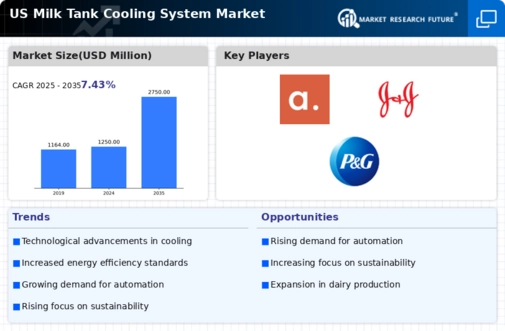Rising Dairy Production
The increasing demand for dairy products in the US has led to a rise in dairy production, which in turn drives the milk tank-cooling-system market. As dairy farms expand their operations to meet consumer needs, the requirement for efficient cooling systems becomes paramount. In 2025, the US dairy production is projected to reach approximately 100 million metric tons, necessitating advanced cooling solutions to maintain product quality and safety. The milk tank-cooling-system market is thus experiencing growth as farmers seek to invest in technology that ensures optimal milk storage temperatures, reducing spoilage and enhancing shelf life. This trend indicates a robust market potential, as producers recognize the importance of maintaining milk quality from farm to consumer.
Environmental Regulations
The milk tank-cooling-system market is increasingly influenced by environmental regulations aimed at reducing the carbon footprint of dairy operations. As the US government enforces stricter emissions standards, dairy farms are seeking energy-efficient cooling solutions that comply with these regulations. The market is expected to see a shift towards eco-friendly cooling systems, which utilize natural refrigerants and consume less energy. By 2025, it is anticipated that over 40% of new installations will incorporate sustainable technologies, reflecting a growing commitment to environmental stewardship within the milk tank-cooling-system market. This trend not only addresses regulatory compliance but also appeals to environmentally conscious consumers.
Technological Integration
The integration of advanced technologies in the milk tank-cooling-system market is transforming the industry landscape. Innovations such as IoT-enabled cooling systems allow for real-time monitoring and control of milk temperatures, enhancing efficiency and reducing energy consumption. In 2025, it is estimated that around 30% of dairy farms in the US will adopt smart cooling technologies, reflecting a shift towards automation and data-driven decision-making. This technological evolution not only improves operational efficiency but also aligns with the growing consumer demand for transparency in food production. As a result, the milk tank-cooling-system market is likely to witness increased investments in smart technologies, further driving market growth.
Increased Focus on Food Safety
Food safety remains a critical concern in the dairy industry, significantly impacting the milk tank-cooling-system market. With rising consumer awareness regarding foodborne illnesses, dairy producers are compelled to adhere to stringent safety standards. The US government has implemented regulations that require maintaining milk at specific temperatures to prevent bacterial growth. As a result, the demand for reliable cooling systems is expected to surge, with the market projected to grow by approximately 15% annually through 2027. This heightened focus on food safety not only drives the adoption of advanced cooling technologies but also reinforces the importance of the milk tank-cooling-system market in ensuring public health.
Growing Demand for Quality Assurance
The increasing consumer demand for high-quality dairy products is a significant driver for the milk tank-cooling-system market. As consumers become more discerning about the quality and freshness of milk, dairy producers are compelled to invest in advanced cooling systems that ensure optimal storage conditions. The market is projected to grow by 12% annually as producers recognize that maintaining milk quality is essential for brand reputation and customer loyalty. This trend highlights the critical role of the milk tank-cooling-system market in supporting dairy producers in their quest for quality assurance, ultimately benefiting consumers who seek premium dairy products.














Leave a Comment